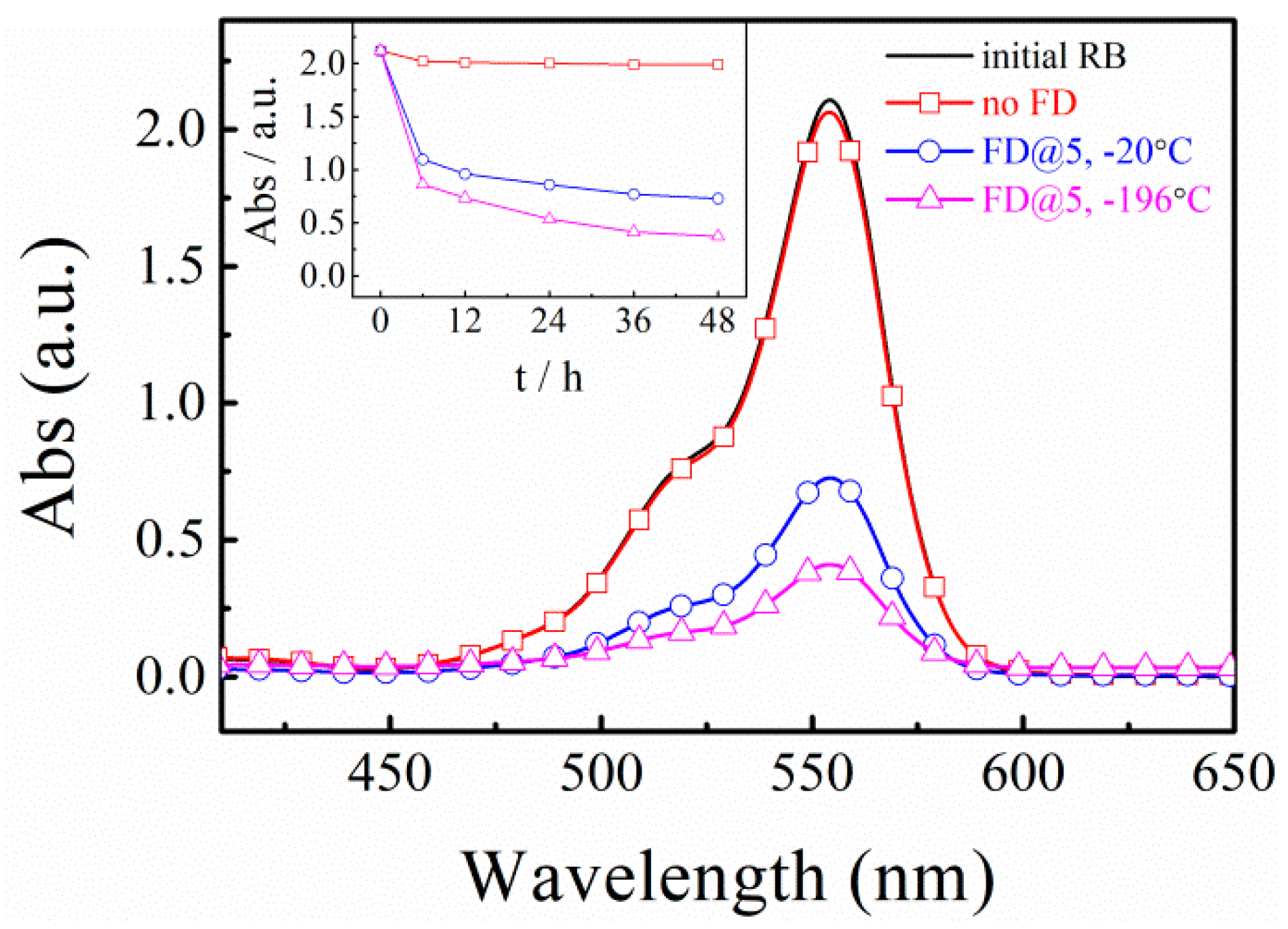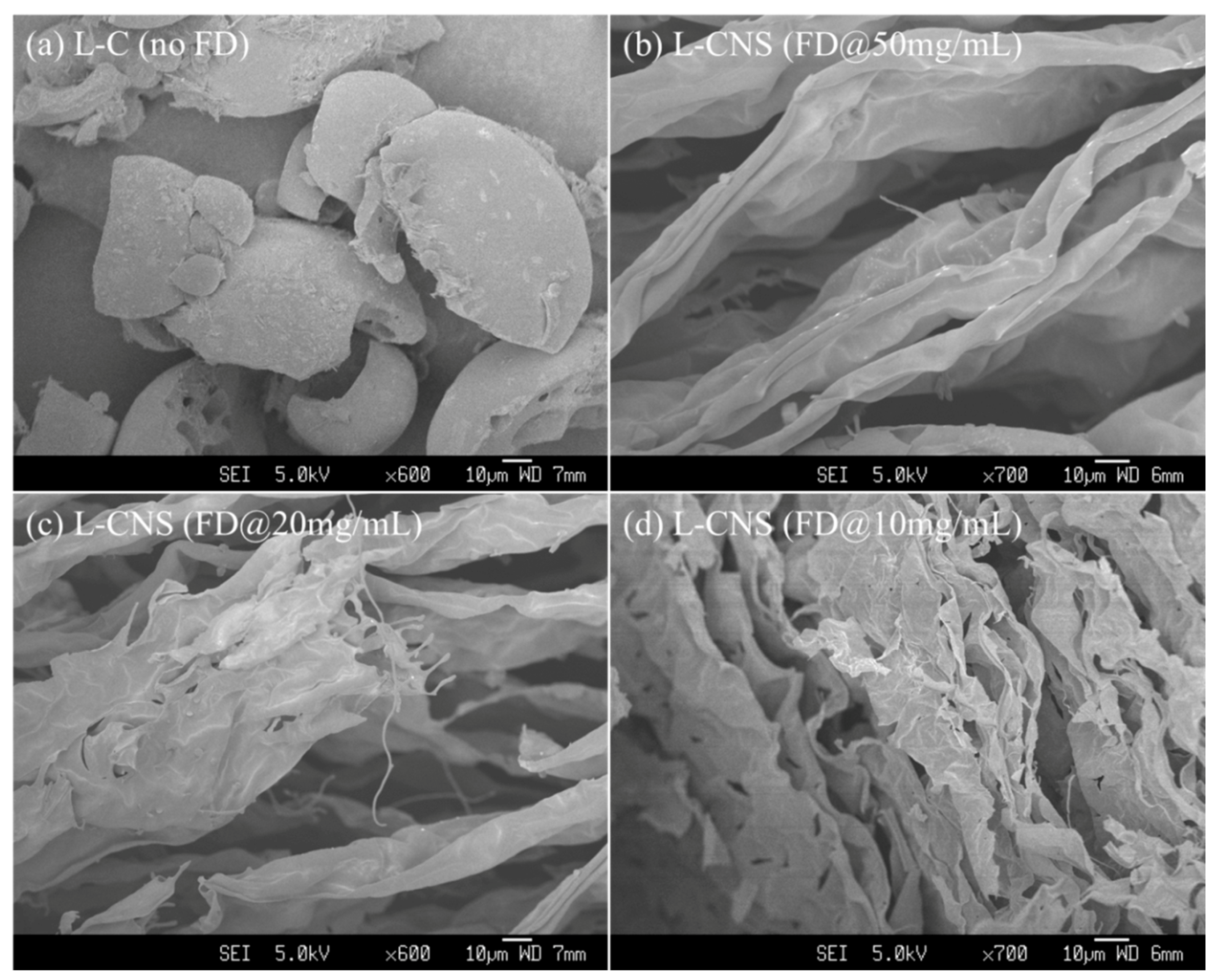High-Yield Production of Lignin-Derived Functional Carbon Nanosheet for Dye Adsorption
Abstract
:1. Introduction
2. Materials and Methods
2.1. Materials
2.2. Preparation of Lignin-Derived Carbon Adsorbents
2.3. Characterization
3. Results and Discussion
3.1. Effects of FD and Freezing Temperature
3.2. Concentration Effects of Lignin Aqueous Solution
3.3. Catalysts for Lignin Carbonization
4. Conclusions
Supplementary Materials
Author Contributions
Funding
Acknowledgments
Conflicts of Interest
References
- Shannon, M.A.; Bohn, P.W.; Elimelech, M.; Georgiadis, J.G.; Marinas, B.J.; Mayes, A.M. Science and technology for water purification in the coming decades. Nature 2008, 452, 301–310. [Google Scholar] [CrossRef] [PubMed]
- Sun, Y.; Yu, F.; Li, C.; Dai, X.; Ma, J. Nano-/Micro-confined Water in Graphene Hydrogel as Superadsorbents for Water Purification. Nano-Micro. Lett. 2019, 12. [Google Scholar] [CrossRef] [Green Version]
- Sophia, A.C.; Lima, E.C. Removal of emerging contaminants from the environment by adsorption. Ecotoxicol. Environ. Saf. 2018, 150, 1–17. [Google Scholar] [CrossRef] [PubMed]
- Collivignarelli, M.C.; Abba, A.; Carnevale Miino, M.; Damiani, S. Treatments for color removal from wastewater: State of the art. J. Environ. Manag. 2019, 236, 727–745. [Google Scholar] [CrossRef]
- Tian, J.; Shao, Q.; Zhao, J.; Pan, D.; Dong, M.; Jia, C.; Ding, T.; Wu, T.; Guo, Z. Microwave solvothermal carboxymethyl chitosan templated synthesis of TiO2/ZrO2 composites toward enhanced photocatalytic degradation of Rhodamine B. J. Colloid Interface Sci. 2019, 541, 18–29. [Google Scholar] [CrossRef]
- Alatalo, S.M.; Pileidis, F.; Makila, E.; Sevilla, M.; Repo, E.; Salonen, J.; Sillanpaa, M.; Titirici, M.M. Versatile Cellulose-Based Carbon Aerogel for the Removal of Both Cationic and Anionic Metal Contaminants from Water. ACS Appl. Mater. Interfaces 2015, 7, 25875–25883. [Google Scholar] [CrossRef]
- Zhang, H.; Li, Y.; Zhao, Y.; Li, G.; Zhang, F. Carbon Black Oxidized by Air Calcination for Enhanced H2O2 Generation and Effective Organics Degradation. ACS Appl. Mater. Interfaces 2019, 11, 27846–27853. [Google Scholar] [CrossRef]
- Li, S.C.; Hu, B.C.; Ding, Y.W.; Liang, H.W.; Li, C.; Yu, Z.Y.; Wu, Z.Y.; Chen, W.S.; Yu, S.H. Wood-Derived Ultrathin Carbon Nanofiber Aerogels. Angew. Chem. Int. Ed. Engl. 2018, 57, 7085–7090. [Google Scholar] [CrossRef]
- Xu, X.; Zhou, J.; Nagaraju, D.H.; Jiang, L.; Marinov, V.R.; Lubineau, G.; Alshareef, H.N.; Oh, M. Flexible, Highly Graphitized Carbon Aerogels Based on Bacterial Cellulose/Lignin: Catalyst-Free Synthesis and its Application in Energy Storage Devices. Adv. Funct. Mater. 2015, 25, 3193–3202. [Google Scholar] [CrossRef]
- Yang, B.; Liu, Y.; Liang, Q.; Chen, M.; Ma, L.; Li, L.; Liu, Q.; Tu, W.; Lan, D.; Chen, Y. Evaluation of activated carbon synthesized by one-stage and two-stage co-pyrolysis from sludge and coconut shell. Ecotoxicol. Environ. Saf. 2019, 170, 722–731. [Google Scholar] [CrossRef]
- Mohanty, A.K.; Vivekanandhan, S.; Pin, J.-M.; Misra, M. Composites from renewable and sustainable resources: Challenges and innovations. Science 2018, 362, 536–542. [Google Scholar] [CrossRef] [Green Version]
- Wu, Z.Y.; Li, C.; Liang, H.W.; Chen, J.F.; Yu, S.H. Ultralight, flexible, and fire-resistant carbon nanofiber aerogels from bacterial cellulose. Angew. Chem. Int. Ed. Engl. 2013, 52, 2925–2929. [Google Scholar] [CrossRef] [PubMed]
- Qian, Y.; Lou, H.M.; Liu, W.F.; Yang, D.J.; Ouyang, X.P.; Li, Y.; Qiu, X.Q. Lignin—a promising biomass resource. Tappi J. 2018, 17, 125–141. [Google Scholar] [CrossRef]
- Supanchaiyamat, N.; Jetsrisuparb, K.; Knijnenburg, J.T.N.; Tsang, D.C.W.; Hunt, A.J. Lignin materials for adsorption: Current trend, perspectives and opportunities. Bioresour. Technol. 2019, 272, 570–581. [Google Scholar] [CrossRef] [PubMed]
- Ponnusamy, V.K.; Nguyen, D.D.; Dharmaraja, J.; Shobana, S.; Banu, J.R.; Saratale, R.G.; Chang, S.W.; Kumar, G. A review on lignin structure, pretreatments, fermentation reactions and biorefinery potential. Bioresour. Technol. 2019, 271, 462–472. [Google Scholar] [CrossRef] [PubMed]
- Tian, D.; Hu, J.; Bao, J.; Chandra, R.P.; Saddler, J.N.; Lu, C. Lignin valorization: Lignin nanoparticles as high-value bio-additive for multifunctional nanocomposites. Biotechnol. Biofuels 2017, 10, 192. [Google Scholar] [CrossRef] [Green Version]
- Norgren, M.; Edlund, H. Lignin: Recent advances and emerging applications. Curr. Opin. Colloid Interface Sci. 2014, 19, 409–416. [Google Scholar] [CrossRef]
- Wang, X.; Jiang, C.; Hou, B.; Wang, Y.; Hao, C.; Wu, J. Carbon composite lignin-based adsorbents for the adsorption of dyes. Chemosphere 2018, 206, 587–596. [Google Scholar] [CrossRef]
- Wawrzkiewicz, M.; Bartczak, P.; Jesionowski, T. Enhanced removal of hazardous dye form aqueous solutions and real textile wastewater using bifunctional chitin/lignin biosorbent. Int. J. Biol. Macromol. 2017, 99, 754–764. [Google Scholar] [CrossRef]
- Suhas, P.J.M.C.; Carrott, M.M.L.R. Lignin-from natural adsorbent to activated carbon: A review. Bioresour. Technol. 2007, 98, 2301–2312. [Google Scholar] [CrossRef]
- Chen, F.; Shahabadi, S.I.S.; Zhou, D.; Liu, W.; Kong, J.; Xu, J.; Lu, X. Facile preparation of cross-linked lignin for efficient adsorption of dyes and heavy metal ions. React. Funct. Polym. 2019, 143, 104336. [Google Scholar] [CrossRef]
- Smichi, N.; Messaoudi, Y.; Gargouri, M. Lignocellulosic Biomass Fractionation: Production of Ethanol, Lignin and Carbon Source for Fungal Culture. Waste Biomass Valorizat. 2018, 9, 947–956. [Google Scholar] [CrossRef]
- Zhang, X.; Yan, Q.; Li, J.; Chu, I.W.; Toghiani, H.; Cai, Z.; Zhang, J. Carbon-Based Nanomaterials from Biopolymer Lignin via Catalytic Thermal Treatment at 700 to 1000 °C. Polymers 2018, 10, 183. [Google Scholar] [CrossRef] [PubMed] [Green Version]
- Chatterjee, S.; Saito, T. Lignin-Derived Advanced Carbon Materials. ChemSusChem 2015, 8, 3941–3958. [Google Scholar] [CrossRef]
- Wang, H.; Mi, X.; Li, Y.; Zhan, S. 3D Graphene-Based Macrostructures for Water Treatment. Adv. Mater. 2020, 32, e1806843. [Google Scholar] [CrossRef]
- Sajjadi, S.A.; Meknati, A.; Lima, E.C.; Dotto, G.L.; Mendoza-Castillo, D.I.; Anastopoulos, I.; Alakhras, F.; Unuabonah, E.I.; Singh, P.; Hosseini-Bandegharaei, A. A novel route for preparation of chemically activated carbon from pistachio wood for highly efficient Pb(II) sorption. J. Environ. Manag. 2019, 236, 34–44. [Google Scholar] [CrossRef]
- Hayashi, J.; Kazehaya, A.; Muroyama, K.; Watkinson, A.P. Preparation of activated carbon from lignin by chemical activation. Carbon 2000, 38, 1873–1878. [Google Scholar] [CrossRef]
- Sun, H.; Xu, Z.; Gao, C. Multifunctional, ultra-flyweight, synergistically assembled carbon aerogels. Adv. Mater. 2013, 25, 2554–2560. [Google Scholar] [CrossRef]
- Anoshkin, I.V.; Campion, J.; Lioubtchenko, D.V.; Oberhammer, J. Freeze-Dried Carbon Nanotube Aerogels for High-Frequency Absorber Applications. ACS Appl. Mater. Interfaces 2018, 10, 19806–19811. [Google Scholar] [CrossRef] [Green Version]
- Yi, L.; Yang, J.; Fang, X.; Xia, Y.; Zhao, L.; Wu, H.; Guo, S. Facile fabrication of wood-inspired aerogel from chitosan for efficient removal of oil from Water. J. Hazard. Mater. 2020, 385, 121507. [Google Scholar] [CrossRef]
- Le Van, K.; Luong Thi, T.T. Activated carbon derived from rice husk by NaOH activation and its application in supercapacitor. Prog. Nat. Sci. Mater. Int. 2014, 24, 191–198. [Google Scholar] [CrossRef] [Green Version]
- O’Brien, F. Influence of freezing rate on pore structure in freeze-dried collagen-GAG scaffolds. Biomaterials 2004, 25, 1077–1086. [Google Scholar] [CrossRef]
- Shakir, K.; Elkafrawy, A.F.; Ghoneimy, H.F.; Elrab Beheir, S.G.; Refaat, M. Removal of rhodamine B (a basic dye) and thoron (an acidic dye) from dilute aqueous solutions and wastewater simulants by ion flotation. Water Res. 2010, 44, 1449–1461. [Google Scholar] [CrossRef] [PubMed]
- Baslak, C.; Arslan, G.; Kus, M.; Cengeloglu, Y. Removal of Rhodamine B from water by using CdTeSe quantum dot-cellulose membrane composites. RSC Adv. 2016, 6, 18549–18557. [Google Scholar] [CrossRef]



| Sample | Freezing Temp. (°C) | Carbonization Temp. (°C) | Specific Surface Area (m2/g) | Pore Volume (cm3/g) | RB Adsorption Capacity (mg/g) 1 |
|---|---|---|---|---|---|
| lignin | – 2 | – 3 | 0 | 0 | – 4 |
| L-C | – 2 | 1000 | 1 | 0.01 | 1.0 |
| L-CNS@-20 | –20 | 1000 | 204 | 0.09 | 32.9 |
| L-CNS@-196 | −196 | 1000 | 403 | 0.17 | 41.2 |
| Sample | Concentration (mg/mL) | Surface Area (m2/g) | Pore Volume (cm3/g) | RB Adsorption Capacity 1 (mg/g) | Product Yield (%) |
|---|---|---|---|---|---|
| C-5 | 5 | 403 | 0.17 | 41.2 | 15.7 |
| C-10 | 10 | 305 | 0.12 | 10.9 | 23.5 |
| C-20 | 20 | 143 | 0.05 | 2.98 | 32.3 |
| C-50 | 50 | 26 | 0.03 | 1.75 | 41.9 |
| Sample | Catalyst | Catalyst Content (%) | Lignin Concentration (mg/mL) | Surface Area (m2/g) | RB Adsorption Capacity 1 (mg/g) | Product Yield (%) |
|---|---|---|---|---|---|---|
| L-CNS | – | 0 | 50 | 26 | 0.82 | 41.9 |
| L-CNS/NaOH | NaOH | 5 | 50 | 214 | 2.88 | 42.0 |
| L-CNS/TsOH | TsOH | 5 | 50 | 21 | 0.77 | 52.6 |
© 2020 by the authors. Licensee MDPI, Basel, Switzerland. This article is an open access article distributed under the terms and conditions of the Creative Commons Attribution (CC BY) license (http://creativecommons.org/licenses/by/4.0/).
Share and Cite
Chen, F.; Hu, X.; Tu, X.; Chen, L.; Liu, X.; Tan, L.; Mao, Y.; Shi, J.; Teng, X.; He, S.; et al. High-Yield Production of Lignin-Derived Functional Carbon Nanosheet for Dye Adsorption. Polymers 2020, 12, 797. https://doi.org/10.3390/polym12040797
Chen F, Hu X, Tu X, Chen L, Liu X, Tan L, Mao Y, Shi J, Teng X, He S, et al. High-Yield Production of Lignin-Derived Functional Carbon Nanosheet for Dye Adsorption. Polymers. 2020; 12(4):797. https://doi.org/10.3390/polym12040797
Chicago/Turabian StyleChen, Fenggui, Xi Hu, Xiaohan Tu, Linfei Chen, Xi Liu, Linli Tan, Yulin Mao, Jianwei Shi, Xiaoxu Teng, Shuhua He, and et al. 2020. "High-Yield Production of Lignin-Derived Functional Carbon Nanosheet for Dye Adsorption" Polymers 12, no. 4: 797. https://doi.org/10.3390/polym12040797
APA StyleChen, F., Hu, X., Tu, X., Chen, L., Liu, X., Tan, L., Mao, Y., Shi, J., Teng, X., He, S., Qin, Z., Xu, J., & Wu, J. (2020). High-Yield Production of Lignin-Derived Functional Carbon Nanosheet for Dye Adsorption. Polymers, 12(4), 797. https://doi.org/10.3390/polym12040797






